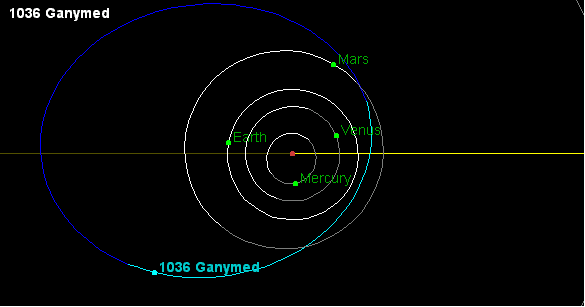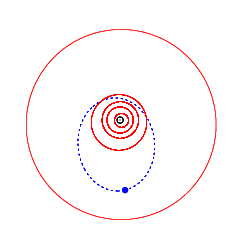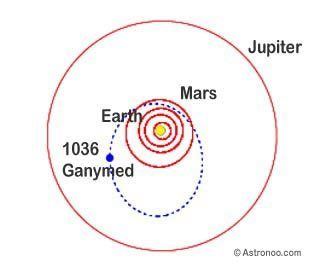Discovered by W. Baade Pronunciation /ˈɡænᵻmɛd/ Discovered 23 October 1924 | Discovery date 23 October 1924 Observation arc 91.09 yr (33272 days) Orbits Sun Discovery site Hamburg Observatory | |
 | ||
Alternative names 1924 TD; 1952 BF; 1954 HH Minor planet category Amor III asteroid,Mars-crosser asteroid Similar Sun, Solar System, Asteroid belt, 1627 Ivar, 433 Eros | ||
1036 Ganymed is the largest near-Earth asteroid, at about 32–34 km in diameter. It was discovered by Walter Baade on October 23, 1924. It has a very well determined orbit, and its next pass of the Earth will be at a distance of 0.374097 AU (55,964,100 km; 34,774,500 mi) on 13 October 2024. It is an Amor asteroid, and also a Mars-crosser asteroid, and will pass 0.02868 AU (4,290,000 km; 2,666,000 mi) from Mars on 16 December 2176.
Contents

Name
Ganymed is the German spelling of Ganymede, the Trojan prince turned god whom Zeus designated the cupbearer to the Greek gods. Jupiter's moon Ganymede is named after the same, but uses the English spelling.
Physical characteristics
Owing to its early discovery date, Ganymed has a rich observational history. A 1931 paper published the absolute magnitude, based on observations to date, as 9.24, slightly brighter than the present value of 9.45. Ganymed is an S-type asteroid, meaning that it is relatively reflective and composed of iron and magnesium silicates. Spectral measurements put Ganymed in the S (VI) spectral subtype, indicating a surface rich in orthopyroxenes, and possibly metals (although if metals are present they are covered and not readily apparent in the spectra).

In 1998, radar observations of Ganymed by the Arecibo radio telescope produced images of the asteroid, revealing a roughly spherical object. Also around this time a study of several asteroids' visual lightcurves (variation of light intensity over time) and polarization curves was conducted (the data for Ganymed is limited due to poor weather at the time). The study concluded that there was a weak correlation between the lightcurve and polarimetry curve as a function of rotation angle. Because polarization is dependent on surface terrain and composition, rather than the observed size of the object like the lightcurve, this suggests that the surface features of the asteroid are roughly uniform over its observed surface.

More recent observations of Ganymed's lightcurve, reported in 2007, confirm a rotation period of 10.314 ± 0.004 h and a lightcurve amplitude of 0.12 mag.
An occultation of a star by Ganymed was observed from California on August 22, 1985.
